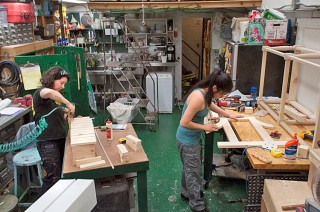Column Name
Title
Subhead

In the bustling prop shop, carpenter/artisan Ari Zindler (left) builds planter boxes for Twelfth Night while intern J. J. Hu builds a chaise for Hamlet.
(Photo by Jeffrey Cuyubamba)Like a sword fight without swords or a Hamlet without a skull, a world without the prop shop would surely be a dysfunctional one. Props play a major role in shows across all three of Juilliard’s divisions, so it’s no surprise that the prop shop takes up a two-floor area of the Juilliard building and an offsite warehouse and employs four staff members plus interns. The Juilliard prop collection ranges from real taxidermy to a showroom’s worth of furniture—much of it has been here for decades. Kate Dale is at the helm of the operation, and she’s currently working on the props for the third-year Shakespeare performances, which includes her first Hamlet in her 26 years of working at Juilliard. (For more on Dale, see the Staff Portrait.)
Third-year Drama students present Hamlet, directed by Rebecca Guy, at the Stephanie P. McLelland Drama Theater on May 8, 9, 12, 16, and 18.
Third-year Drama students present Twelfth Night, directed by Vivienne Benesch, at the Stephanie P. McLelland Drama Theater on May 11, 12, 15, 17, and 18.
Body
Prep for the Shakespeare props began as most productions do, months in advance, with a study of the plays. “We’ll read them and know that there are fights or someone’s poisoned or something like that. Shakespeare gets interpreted in any number of periods so maybe they’re sword fighting or maybe there are guns or maybe there’s something else,” Dale told The Journal. Based on the text, the shop will have a slight idea of what will be involved, but Dale and her crew hold off on making too many decisions until the design presentation, when they find out exactly what kind of world the play will take place in.
For this year’s performances, Twelfth Night goes to Mardi Gras in an 1850s New Orleans setting. Hamlet, however, is a bit more complicated, Dale said. “It starts with a group of students rehearsing Hamlet and then, as the play progresses it moves into more traditional—let’s call it generic Shakespearean—costumes and décor.” For the latter, the prop team is working more closely with the rehearsal process than usual, since the props play such a distinct role in telling the story. In the beginning of the play, for example, the actors are using chairs that could be rehearsal chairs or older chairs, and then later in the play the props get more specific, with thrones and more Shakespearean-looking items.
Dale can’t recall exactly how many times she’s done Twelfth Night, but it’s not her favorite. “The characters are unlikeable. Why they mistreat poor Malvolio, I just don’t know,” she said. (Although she later recalled a past production that triggered some good laughs—an interpretation where, instead of some of the characters getting into bushes, they dressed like bushes.) Props for this year’s production include a fake palm tree and a variety of other plants, a piano, some weapons, and a large scale Mardi Gras-type puppet. The piano was originally supposed to be a player piano, but the latest word from Dale was that the director, Vivienne Benesch, just wanted a regular period-looking piano. But despite Juilliard’s having 270 pianos, the one for this production had to be rented because there wasn’t an appropriate upright on hand.
Juilliard’s prop needs are huge—the shop is responsible for dance, drama, and opera productions, about 25 of them annually—and as many as three to five shows often happen simultaneously. That’s a lot of inventory. Many of Juilliard’s props have been donated from Broadway shows after they close. The skull for Hamlet, “a very nice skull,” Dale said, was a donation. In many cases, the crew builds props specifically for a production. If a prop was time-consuming to build and it’s something that will likely be used again, it’ll be kept, otherwise if it’s something that can easily be built again or is too specific to one production, it gets donated after the show, often to such organizations as Materials for the Arts, which provides art materials to public schools for free.
All tens of thousands of the props are catalogued in a database, so a director can go review all of the shop’s chairs, for example, and determine which would be the best fit for a production. From there, the piece might need to be painted or upholstered. Dale and her team also need to pay close attention to how the props are used. During rehearsals, one of their jobs is to answer questions about how a piece of furniture can be treated—if it can be stood on, jumped on, etc.
With food props, the focus, sadly, is not on taste, but on allowing the actors to eat in the easiest way possible. A sandwich, for example, is usually just two slices of bread with a piece of lettuce, “That gives them enough to chew—but not too much—because they have to get it out of their mouth as fast as they can and start talking again,” Dale said. Meat is avoided for sanitation reasons, so in the fourth-year production of Williams in Transit earlier this year, when they needed a salmon loaf, assistant supervisor Mary Reiser talked her mom into making enough carrot loafs for the run. “Sometimes you have to think outside the box,” Dale noted.
The Shakespeare performances present new challenges every year, and five years ago, the ante was upped when the third-years started doing two plays instead of one. From there, Dale had to account for the time it would take to changeover the props between performances—both plays use the same set, a mockup of the Globe Theater—and space is always a constraint. Getting a bed on that set is super tricky because of the space limitations. Despite these challenges, or even because of these challenges, Dale loves the prop shop because it’s never boring. “There’s no ride like this at Disneyland,” she said. “I’ve always said I don’t have to go anywhere to get a new job—the job changes enough that I always have a new job.”





